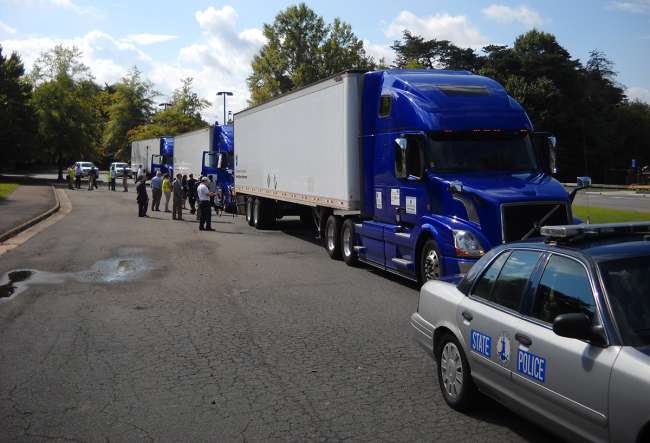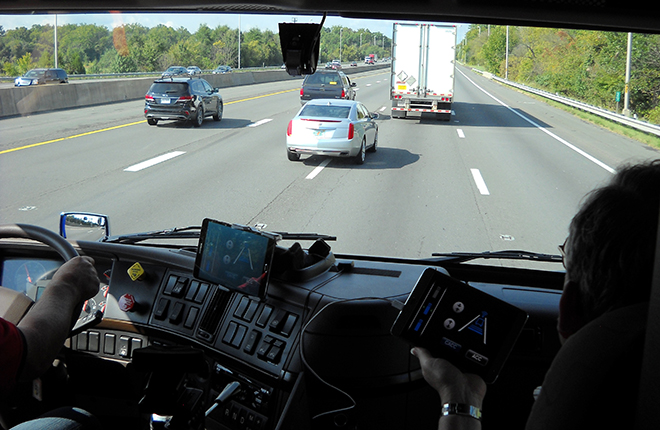FHWA Demonstrates 3-Truck Platoon in Virginia

CENTREVILLE, Va. — Lawmakers gave and listened to earnest speeches on vehicle automation last week, and the nation’s transportation secretary held forth on the subject at a university, but 28 miles west of Capitol Hill the engineers took over and showed what platooning technology for trucks can do today.
With help from the Virginia State Police, the Federal Highway Administration demonstrated a three-truck platoon Sept. 14, plying an 8-mile course on a state highway. The closest following distance between trucks during one of the test drives was 45 to 50 feet at 55 mph — a following gap of just 0.6 second.
Computers on the three trucks “talked” among themselves via dedicated short-range communications (DSRC), a type of radio using 5.9 gigahertz transmission.
“This is important for highway efficiency,” said Michael Trentacoste, director of FHWA’s Office of Research, Development and Technology.
“We’re not able to increase the number of lane-miles quickly, so we want to look at trucks driving closely together and operating safely,” Trentacoste said.
The North American Council for Freight Efficiency also has analyzed the technology and said trucks running in close proximity can improve fuel efficiency by reducing combined aerodynamic drag.
Volvo Trucks North America has been keen on platooning, working with University of California researchers and with Peloton Technology. The system used in the demonstration here was developed by the university’s Partners for Advanced Transportation Technology program, or PATH. The three trucks were Volvo VNL 670s.
Trentacoste said two-truck platoon systems could be commercially available as early as next year, but VTNA spokesman Brandon Borgna was more cautious.
“If you look at autonomous technology and its adoption, it’s driven by customer need, demand and benefit. There’s a growing appetite for autonomous and semi-autonomous technology,” Borgna said.
“We are heavily invested in this, and we’ll be prepared when there is a market demand for it,” he said.
Borgna sidestepped requests for a specific date but said in some sense platooning and driverless trucking is already here — just not on the highways. Volvo Group is a major manufacturer of construction equipment, and some of its massive mining vehicles are run without drivers, but under controlled, off-road conditions.

The Sept. 14 demonstration included a "cut-in," when a car wedged itself between two of the three trucks in the convoy. (Jonathan S. Reiskin/Transport Topics)
In the test here, all three trucks had drivers. Once the system was turned on, though, the drivers in the two following vehicles needed only their hands for steering. Technology took care of braking and accelerating.
The demonstration included a cut-in segment, when a car wedged itself into the gap between two of the three trucks. The radar mounted on the Volvos calculated a following distance so the trucks could travel safely even though a car had joined.
The demonstration did not include a stomp-the-brakes-hard segment.
“For that, you would need a closed course,” said Steven Shladover, the platoon project manager and a PATH researcher.
Shladover said platooning is one example of vehicle-to-vehicle communication, or V2V, through DSRC. He said there also is vehicle-to-infrastructure communication, or V2I, and that trucks could get important information from highways, bridges or stoplights.
Virginia Trucking Association President Dale Bennett came up from Richmond for the demonstration and rode the course as a passenger in one of the trucks.
Bennett said it is important to separate the novel experience of a new technology from the tough details of putting it to work.
“If there’s no return on investment, you can’t make money with it,” he said.
Bennett ran through a list of pros and cons for platooning. The fuel-efficiency benefit, he said, only kicks in for long-distance, high-speed drives. Short distribution runs through dense metropolitan areas get no advantage.
He also was skeptical about how drivers and trucks from different companies would cooperate.
However, he did not slam the door on platooning.
“The initial application for rolling this out would probably be a large fleet,” he said.
A large parcel fleet, less-than-truckload carrier or private fleet all might be candidates for early adoption, he said.
State legislatures also are an issue, he said, as they set many highway rules, including following distance.
Bennett said legislators in Richmond have not yet asked him about platooning, but at some point, “You will have to prove to them that this can be done safely. That’s the hurdle.”

